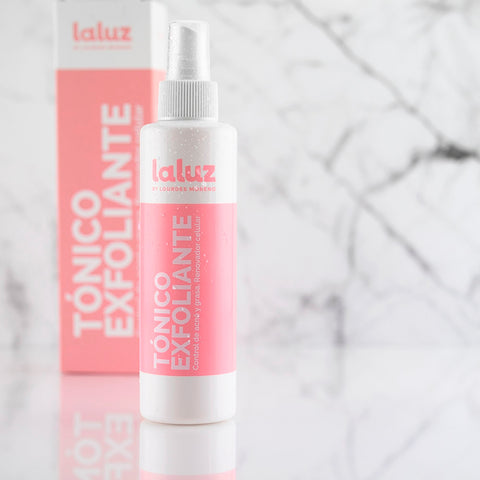
What is exfoliation?
Exfoliating your body is basically removing layers of skin. Approximately every 30 days we naturally shed dead skin to make way for new cells to form on the top layer of our skin.
The epidermis, or the top layer of the skin, is made up of five sub-layers. In the deepest layer, new skin cells are born. As they mature, these cells rise to the top layer. They then tend to fall off naturally, allowing new, smoother, more evenly pigmented skin to emerge.
But the truth is that this process tends to slow down due to a number of factors such as sun exposure, hormonal fluctuations and ageing. When this process is delayed, dead cells begin to accumulate on the skin, making it look rough and dull. If they remain for too long, they can clog your pores: which leads to a whole host of problems, such as spots and fine lines.
What are its benefits?
- Removes dead skin cells.
- Stimulates blood flow and eliminates toxins.
- Provides shine and improves the appearance of the skin.
- It enhances skin renewal, making it more luminous.
- Prepares the skin to better absorb the moisturizers and serums with which you nourish it.
- Prevents the appearance of clogged pores that can cause acne breakouts.
- In the long term, it increases collagen production and skin elasticity.
Is it good to exfoliate?
Sometimes, when dead cells don't shed, our skin looks dull, dry or brittle, and our pores become clogged. Exfoliation can help prevent this effect, as it speeds up the process by sloughing off dead cells from the surface of our skin, while removing dirt and bacteria. This makes our skin smoother, more even and brighter.
Types of Exfoliation
There are three main types of exfoliation: physical, chemical and enzymatic. Each has its own specific characteristics and benefits, suitable for different skin types and needs.
Physical Exfoliants
Physical exfoliants manually remove dead skin cells using small particles or abrasive grains. These products contain ingredients such as sugar, microbeads, rice bran powder, or jojoba seeds. By massaging these ingredients into the skin, microcirculation and lymphatic drainage are improved, resulting in glowing, smooth skin. This type of exfoliation is most effective at removing surface impurities and is ideal for thicker or acne-prone skin.
Chemical Exfoliants
Chemical exfoliants work by dissolving the intercellular “glue” that holds dead skin cells together through the use of acids, such as alpha hydroxy acids (AHAs) and beta hydroxy acids (BHAs). Common ingredients include lactic acid (derived from sour milk) and glycolic acid (extracted from sugar cane). These products allow dead cells to slough off without the need for rubbing, penetrating deeper layers of the skin and boosting cell renewal. Chemical exfoliants are suitable for sensitive skin due to their ability to work without causing mechanical irritation.
Enzyme Exfoliants
Enzyme exfoliants are the gentlest and most suitable for sensitive skin. They use enzymes derived from plants, commonly from fruits such as pineapple, papaya, pumpkin or aloe vera. These enzymes dissolve dead cells without causing friction, leaving the skin clean and irritation-free. This type of exfoliation is ideal for those looking for an effective yet gentle option to keep their skin clear and healthy.
Choosing the Right Exfoliant
Choosing the right type of exfoliant depends on your skin type and specific needs:
- Sensitive skin: Opt for mild chemical or enzymatic exfoliants to avoid irritation.
- Thick or acne-prone skin: Physical exfoliants may be more effective at removing surface impurities and improving skin texture.
- Normal or combination skin: You can alternate between physical and chemical exfoliants to get the benefits of both methods.
Tips to Exfoliate Your Skin Safely and Effectively
Exfoliating your skin properly can improve its appearance and health, but it's important to do it safely to avoid damage. Here are some essential tips:
Frequency
- General: Limit exfoliation to two or three times a week to avoid irritation.
- Oily Skin: May require more frequent exfoliation, but always monitor your skin's reaction.
- Sensitive Skin: Exfoliating once a week is enough, especially as we age.
Post-Exfoliation Care
- Hydration: Always moisturize your skin after exfoliating to maintain its protective barrier.
- Sun Protection: Use sunscreen during the day, as exfoliation can make your skin more sensitive to the sun.
In summary, the key to effective and safe exfoliation is moderation and attention to your skin's specific needs. Start slowly, gradually increase frequency, and always protect and moisturize your skin after exfoliating.
Our Exfoliants
Exfoliating Tonic: Cellular Renewal

This toner provides gentle, safe and controlled exfoliation thanks to the combination of acids and soothing active ingredients in its formulation. Benefits include gentle exfoliation that improves skin texture, antioxidant and anti-aging properties, and natural sun protection that reduces hyperpigmentation and acne. It also prevents and treats blemishes while regulating sebum production.
Assets and Benefits:
- Niacinamide: Reduces hyperpigmentation and acne.
- Gluconolactone: Gently exfoliates the skin and acts as an antioxidant.
- Citric Acid: Provides controlled exfoliation and improves luminosity.
- Lactic Acid: Gentle exfoliant that moisturizes and softens the skin.
15 Glycolic Glow: Serum

This serum with 15% glycolic acid is designed to treat and prevent skin blemishes while improving the quality and luminosity of the skin. Its exfoliating action refines and unifies the skin texture, has anti-aging properties and promotes the production of collagen and elastin, retexturizing and renewing cells.
Assets and Benefits:
- Glycolic Acid: Exfoliates and refines the skin, treats and prevents blemishes, improves luminosity.
- Bisabolol: Soothes and moisturizes the skin.
- Allantoin: Softens and regenerates the skin.
- Aloe Vera: Deeply hydrates and provides anti-inflammatory properties.
Exfoliating Mask: Enzymatic and Physical

This mask combines enzymatic and mechanical exfoliation to achieve cell regeneration in an effective and safe way. It helps renew the stratum corneum, regenerates, nourishes and moisturizes the skin, providing luminosity and improving dark spots. In addition, it has sebum-regulating and anti-aging properties.
Assets and Benefits:
- Exfoliating particles: Physical exfoliation that helps eliminate dead cells.
- Papain and Bromelain: Enzymes that gently exfoliate, regenerate and improve skin texture.
- Cupuaçu Butter and Shea Butter: Deeply nourish and hydrate the skin.
- Almond and Avocado Oil: Provide hydration and softness, improving the luminosity and texture of the skin.




